Masters Research: Waste Glass Powder Effect on Concrete Strength
VerifiedAdded on 2020/05/16
|15
|3929
|87
Report
AI Summary
This research report investigates the effect of waste glass powder on the wet and mechanical properties of cement, aiming to determine the optimal proportion of glass powder (10%, 20%, 30%, and 50%) replacing sand as fine aggregate to achieve maximum compressive strength. The rationale highlights the environmental benefits of using waste glass, addressing its non-biodegradability and reducing landfill waste, while also potentially lowering carbon dioxide emissions and production costs. The research employs a qualitative approach, focusing on exploratory methods, grounded theory, experiments and surveys to understand the changing properties of concrete. The research plan outlines a one-year timeline, detailing the research approach, strategies, and systems of inquiry (deduction, induction, abduction). The objectives include establishing concrete properties with glass powder, identifying mechanical, strength, and physical properties, and investigating the impact of admixtures and supplementary cementitious materials. The study aims to resolve conflicting findings in existing literature and provide insights into the practical application of waste glass powder in construction, emphasizing the importance of precise determination of the optimal glass powder proportion for maximizing concrete strength.
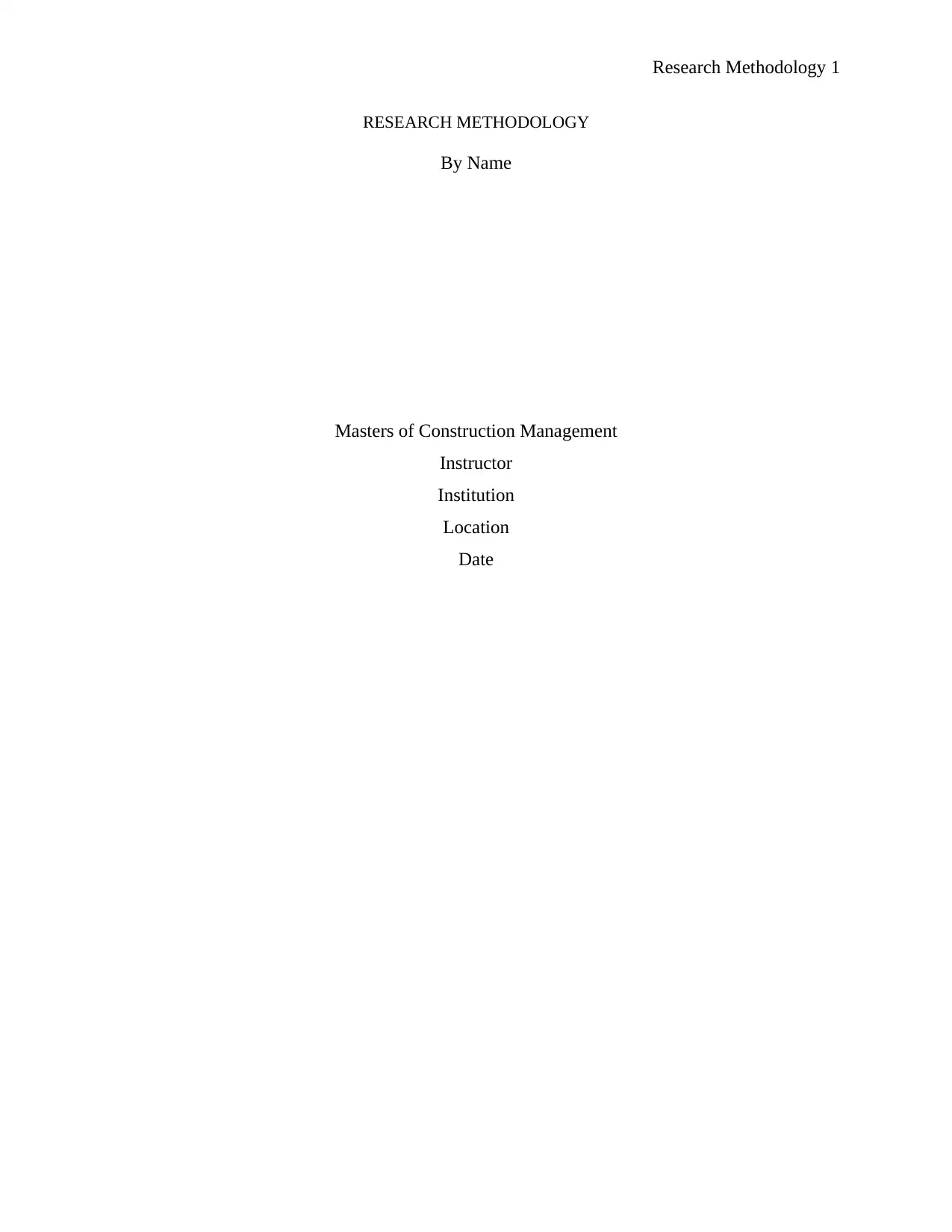
Research Methodology 1
RESEARCH METHODOLOGY
By Name
Masters of Construction Management
Instructor
Institution
Location
Date
RESEARCH METHODOLOGY
By Name
Masters of Construction Management
Instructor
Institution
Location
Date
Paraphrase This Document
Need a fresh take? Get an instant paraphrase of this document with our AI Paraphraser
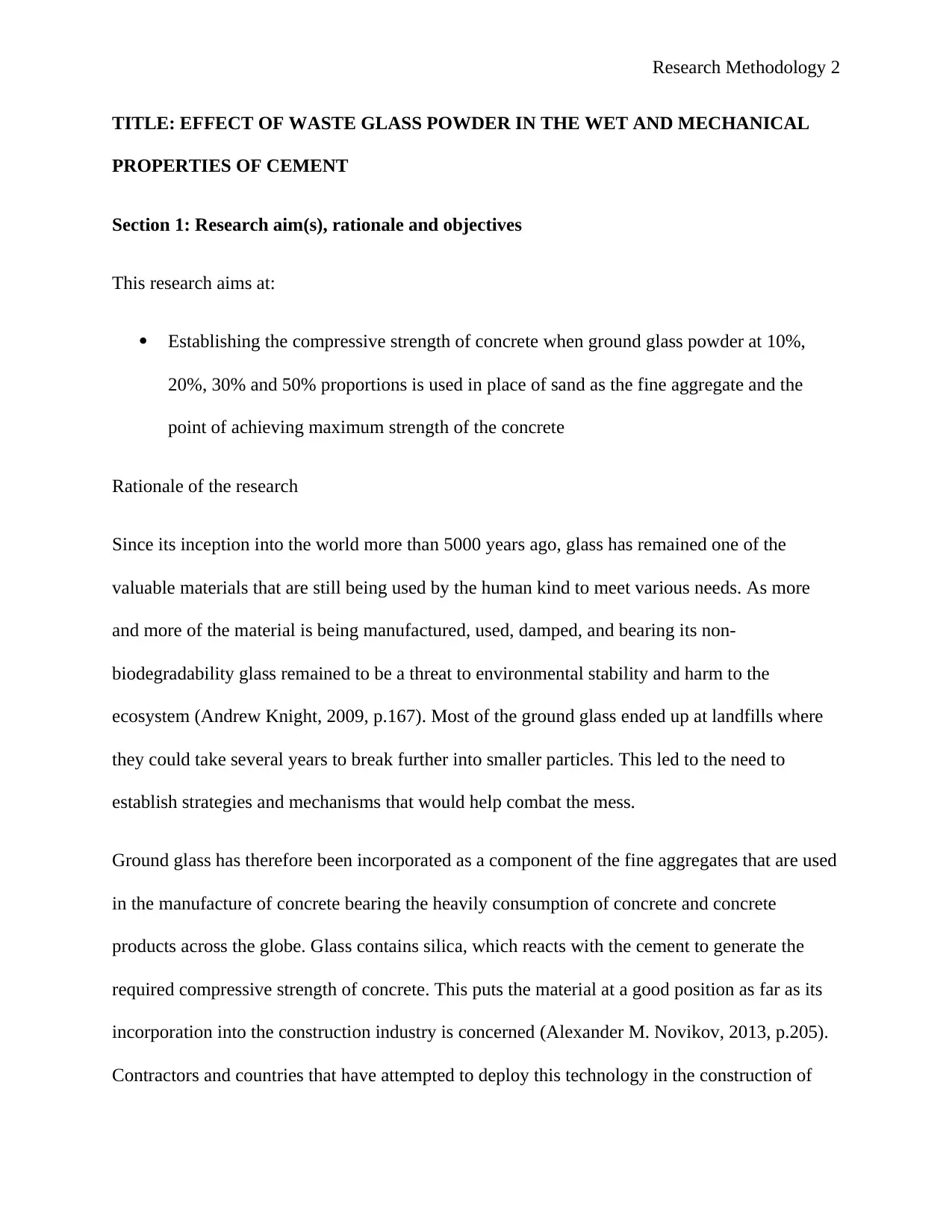
Research Methodology 2
TITLE: EFFECT OF WASTE GLASS POWDER IN THE WET AND MECHANICAL
PROPERTIES OF CEMENT
Section 1: Research aim(s), rationale and objectives
This research aims at:
Establishing the compressive strength of concrete when ground glass powder at 10%,
20%, 30% and 50% proportions is used in place of sand as the fine aggregate and the
point of achieving maximum strength of the concrete
Rationale of the research
Since its inception into the world more than 5000 years ago, glass has remained one of the
valuable materials that are still being used by the human kind to meet various needs. As more
and more of the material is being manufactured, used, damped, and bearing its non-
biodegradability glass remained to be a threat to environmental stability and harm to the
ecosystem (Andrew Knight, 2009, p.167). Most of the ground glass ended up at landfills where
they could take several years to break further into smaller particles. This led to the need to
establish strategies and mechanisms that would help combat the mess.
Ground glass has therefore been incorporated as a component of the fine aggregates that are used
in the manufacture of concrete bearing the heavily consumption of concrete and concrete
products across the globe. Glass contains silica, which reacts with the cement to generate the
required compressive strength of concrete. This puts the material at a good position as far as its
incorporation into the construction industry is concerned (Alexander M. Novikov, 2013, p.205).
Contractors and countries that have attempted to deploy this technology in the construction of
TITLE: EFFECT OF WASTE GLASS POWDER IN THE WET AND MECHANICAL
PROPERTIES OF CEMENT
Section 1: Research aim(s), rationale and objectives
This research aims at:
Establishing the compressive strength of concrete when ground glass powder at 10%,
20%, 30% and 50% proportions is used in place of sand as the fine aggregate and the
point of achieving maximum strength of the concrete
Rationale of the research
Since its inception into the world more than 5000 years ago, glass has remained one of the
valuable materials that are still being used by the human kind to meet various needs. As more
and more of the material is being manufactured, used, damped, and bearing its non-
biodegradability glass remained to be a threat to environmental stability and harm to the
ecosystem (Andrew Knight, 2009, p.167). Most of the ground glass ended up at landfills where
they could take several years to break further into smaller particles. This led to the need to
establish strategies and mechanisms that would help combat the mess.
Ground glass has therefore been incorporated as a component of the fine aggregates that are used
in the manufacture of concrete bearing the heavily consumption of concrete and concrete
products across the globe. Glass contains silica, which reacts with the cement to generate the
required compressive strength of concrete. This puts the material at a good position as far as its
incorporation into the construction industry is concerned (Alexander M. Novikov, 2013, p.205).
Contractors and countries that have attempted to deploy this technology in the construction of
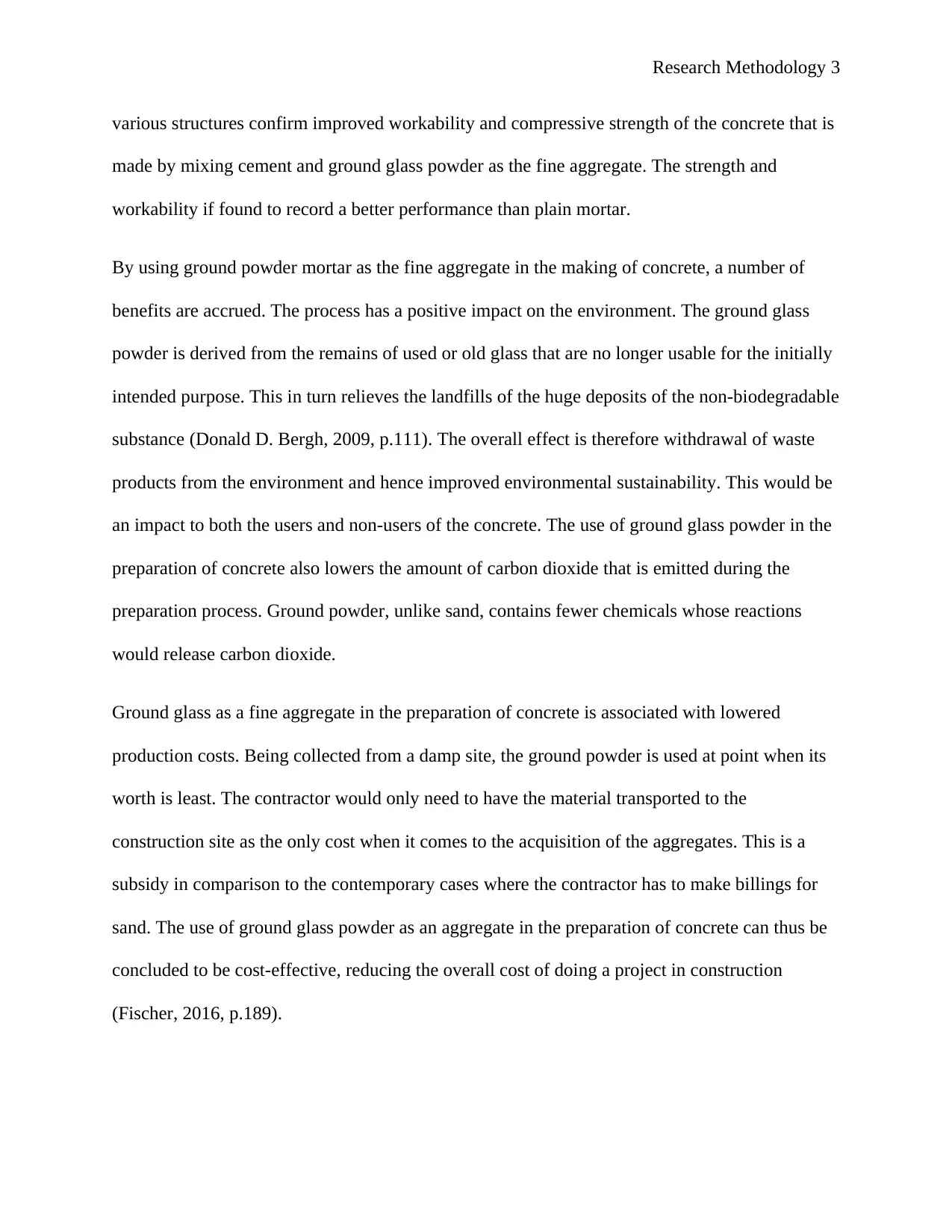
Research Methodology 3
various structures confirm improved workability and compressive strength of the concrete that is
made by mixing cement and ground glass powder as the fine aggregate. The strength and
workability if found to record a better performance than plain mortar.
By using ground powder mortar as the fine aggregate in the making of concrete, a number of
benefits are accrued. The process has a positive impact on the environment. The ground glass
powder is derived from the remains of used or old glass that are no longer usable for the initially
intended purpose. This in turn relieves the landfills of the huge deposits of the non-biodegradable
substance (Donald D. Bergh, 2009, p.111). The overall effect is therefore withdrawal of waste
products from the environment and hence improved environmental sustainability. This would be
an impact to both the users and non-users of the concrete. The use of ground glass powder in the
preparation of concrete also lowers the amount of carbon dioxide that is emitted during the
preparation process. Ground powder, unlike sand, contains fewer chemicals whose reactions
would release carbon dioxide.
Ground glass as a fine aggregate in the preparation of concrete is associated with lowered
production costs. Being collected from a damp site, the ground powder is used at point when its
worth is least. The contractor would only need to have the material transported to the
construction site as the only cost when it comes to the acquisition of the aggregates. This is a
subsidy in comparison to the contemporary cases where the contractor has to make billings for
sand. The use of ground glass powder as an aggregate in the preparation of concrete can thus be
concluded to be cost-effective, reducing the overall cost of doing a project in construction
(Fischer, 2016, p.189).
various structures confirm improved workability and compressive strength of the concrete that is
made by mixing cement and ground glass powder as the fine aggregate. The strength and
workability if found to record a better performance than plain mortar.
By using ground powder mortar as the fine aggregate in the making of concrete, a number of
benefits are accrued. The process has a positive impact on the environment. The ground glass
powder is derived from the remains of used or old glass that are no longer usable for the initially
intended purpose. This in turn relieves the landfills of the huge deposits of the non-biodegradable
substance (Donald D. Bergh, 2009, p.111). The overall effect is therefore withdrawal of waste
products from the environment and hence improved environmental sustainability. This would be
an impact to both the users and non-users of the concrete. The use of ground glass powder in the
preparation of concrete also lowers the amount of carbon dioxide that is emitted during the
preparation process. Ground powder, unlike sand, contains fewer chemicals whose reactions
would release carbon dioxide.
Ground glass as a fine aggregate in the preparation of concrete is associated with lowered
production costs. Being collected from a damp site, the ground powder is used at point when its
worth is least. The contractor would only need to have the material transported to the
construction site as the only cost when it comes to the acquisition of the aggregates. This is a
subsidy in comparison to the contemporary cases where the contractor has to make billings for
sand. The use of ground glass powder as an aggregate in the preparation of concrete can thus be
concluded to be cost-effective, reducing the overall cost of doing a project in construction
(Fischer, 2016, p.189).
⊘ This is a preview!⊘
Do you want full access?
Subscribe today to unlock all pages.

Trusted by 1+ million students worldwide
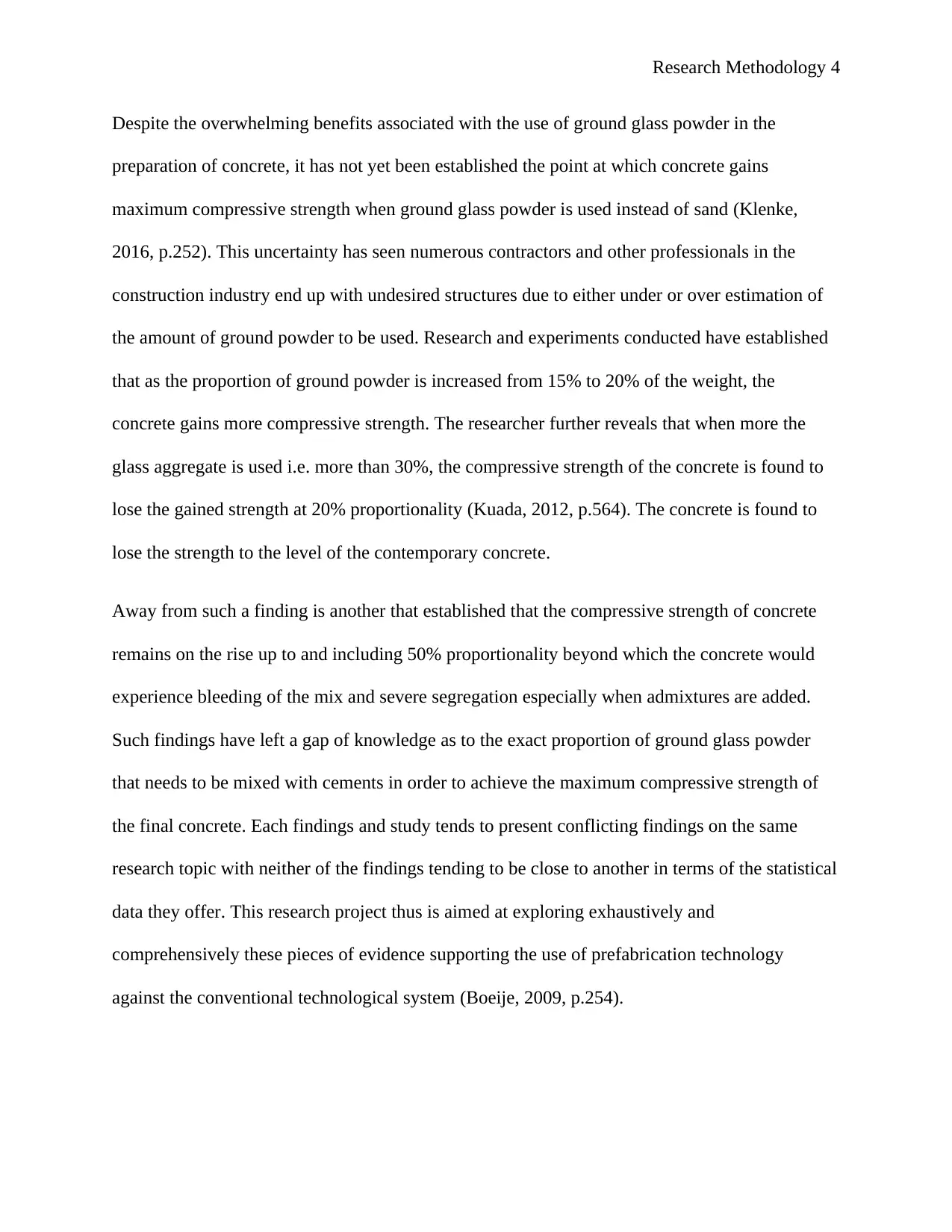
Research Methodology 4
Despite the overwhelming benefits associated with the use of ground glass powder in the
preparation of concrete, it has not yet been established the point at which concrete gains
maximum compressive strength when ground glass powder is used instead of sand (Klenke,
2016, p.252). This uncertainty has seen numerous contractors and other professionals in the
construction industry end up with undesired structures due to either under or over estimation of
the amount of ground powder to be used. Research and experiments conducted have established
that as the proportion of ground powder is increased from 15% to 20% of the weight, the
concrete gains more compressive strength. The researcher further reveals that when more the
glass aggregate is used i.e. more than 30%, the compressive strength of the concrete is found to
lose the gained strength at 20% proportionality (Kuada, 2012, p.564). The concrete is found to
lose the strength to the level of the contemporary concrete.
Away from such a finding is another that established that the compressive strength of concrete
remains on the rise up to and including 50% proportionality beyond which the concrete would
experience bleeding of the mix and severe segregation especially when admixtures are added.
Such findings have left a gap of knowledge as to the exact proportion of ground glass powder
that needs to be mixed with cements in order to achieve the maximum compressive strength of
the final concrete. Each findings and study tends to present conflicting findings on the same
research topic with neither of the findings tending to be close to another in terms of the statistical
data they offer. This research project thus is aimed at exploring exhaustively and
comprehensively these pieces of evidence supporting the use of prefabrication technology
against the conventional technological system (Boeije, 2009, p.254).
Despite the overwhelming benefits associated with the use of ground glass powder in the
preparation of concrete, it has not yet been established the point at which concrete gains
maximum compressive strength when ground glass powder is used instead of sand (Klenke,
2016, p.252). This uncertainty has seen numerous contractors and other professionals in the
construction industry end up with undesired structures due to either under or over estimation of
the amount of ground powder to be used. Research and experiments conducted have established
that as the proportion of ground powder is increased from 15% to 20% of the weight, the
concrete gains more compressive strength. The researcher further reveals that when more the
glass aggregate is used i.e. more than 30%, the compressive strength of the concrete is found to
lose the gained strength at 20% proportionality (Kuada, 2012, p.564). The concrete is found to
lose the strength to the level of the contemporary concrete.
Away from such a finding is another that established that the compressive strength of concrete
remains on the rise up to and including 50% proportionality beyond which the concrete would
experience bleeding of the mix and severe segregation especially when admixtures are added.
Such findings have left a gap of knowledge as to the exact proportion of ground glass powder
that needs to be mixed with cements in order to achieve the maximum compressive strength of
the final concrete. Each findings and study tends to present conflicting findings on the same
research topic with neither of the findings tending to be close to another in terms of the statistical
data they offer. This research project thus is aimed at exploring exhaustively and
comprehensively these pieces of evidence supporting the use of prefabrication technology
against the conventional technological system (Boeije, 2009, p.254).
Paraphrase This Document
Need a fresh take? Get an instant paraphrase of this document with our AI Paraphraser
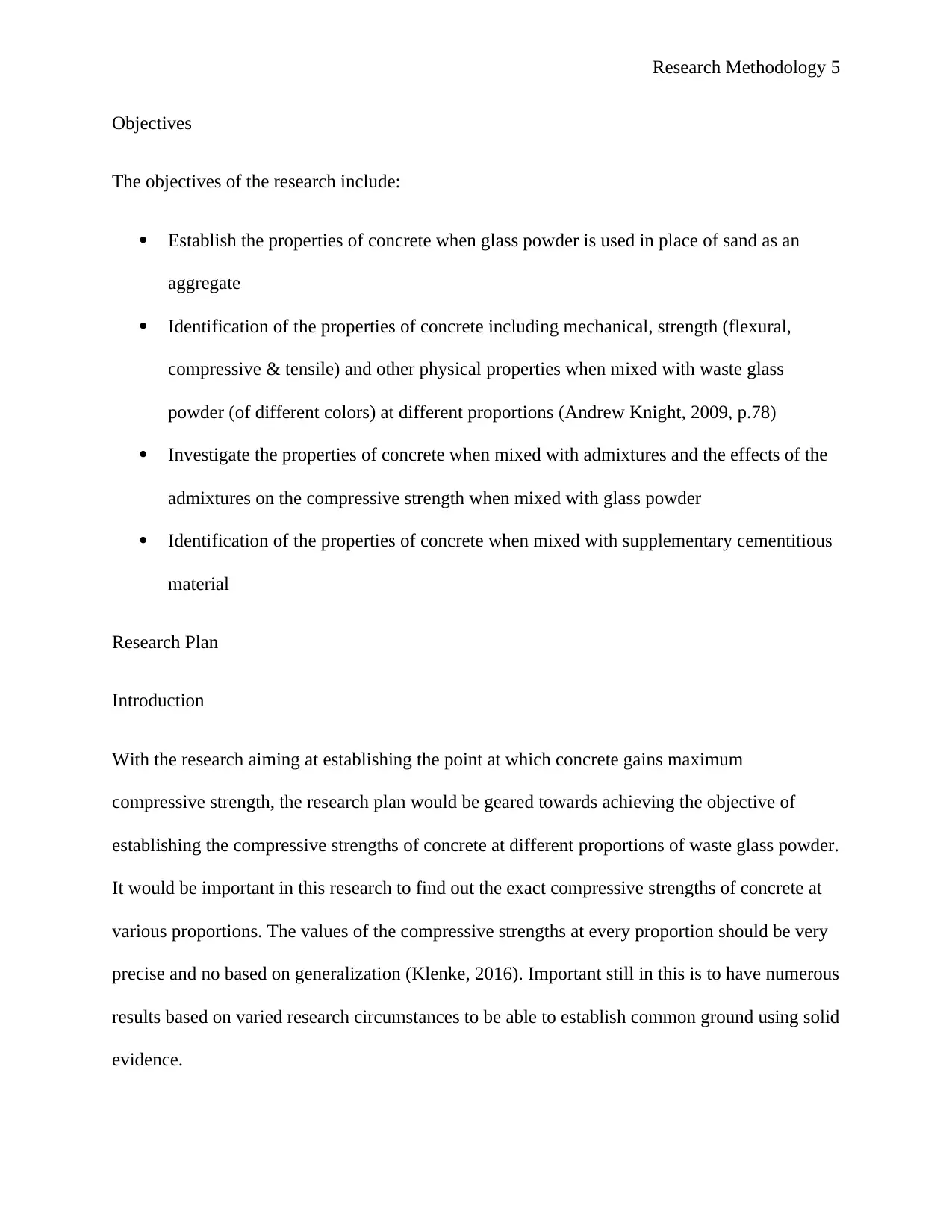
Research Methodology 5
Objectives
The objectives of the research include:
Establish the properties of concrete when glass powder is used in place of sand as an
aggregate
Identification of the properties of concrete including mechanical, strength (flexural,
compressive & tensile) and other physical properties when mixed with waste glass
powder (of different colors) at different proportions (Andrew Knight, 2009, p.78)
Investigate the properties of concrete when mixed with admixtures and the effects of the
admixtures on the compressive strength when mixed with glass powder
Identification of the properties of concrete when mixed with supplementary cementitious
material
Research Plan
Introduction
With the research aiming at establishing the point at which concrete gains maximum
compressive strength, the research plan would be geared towards achieving the objective of
establishing the compressive strengths of concrete at different proportions of waste glass powder.
It would be important in this research to find out the exact compressive strengths of concrete at
various proportions. The values of the compressive strengths at every proportion should be very
precise and no based on generalization (Klenke, 2016). Important still in this is to have numerous
results based on varied research circumstances to be able to establish common ground using solid
evidence.
Objectives
The objectives of the research include:
Establish the properties of concrete when glass powder is used in place of sand as an
aggregate
Identification of the properties of concrete including mechanical, strength (flexural,
compressive & tensile) and other physical properties when mixed with waste glass
powder (of different colors) at different proportions (Andrew Knight, 2009, p.78)
Investigate the properties of concrete when mixed with admixtures and the effects of the
admixtures on the compressive strength when mixed with glass powder
Identification of the properties of concrete when mixed with supplementary cementitious
material
Research Plan
Introduction
With the research aiming at establishing the point at which concrete gains maximum
compressive strength, the research plan would be geared towards achieving the objective of
establishing the compressive strengths of concrete at different proportions of waste glass powder.
It would be important in this research to find out the exact compressive strengths of concrete at
various proportions. The values of the compressive strengths at every proportion should be very
precise and no based on generalization (Klenke, 2016). Important still in this is to have numerous
results based on varied research circumstances to be able to establish common ground using solid
evidence.

Research Methodology 6
Section 2: Research plan for one year of research
Research Approach
Going by the nature of this research, the qualitative approach will be deployed in carrying it out.
This research is more of exploratory in the sense that by the end of the research, the research
should have had an in-depth understanding of the changing properties of concrete as the
proportion of waste glass powder in increased in the preparation of concrete (Lapan, 2011,
p.197). A need to understand the scientific reasoning behind such changes should as well be
established which could then be used to either credit or dismiss the findings in the literature
review.
The qualitative aspect of the research will be an establishment into the cause of variations in the
figures of the compressive strength and where the maximum compressive strength lies in waste
glass powder. An exploration would thus be made through qualitative research to determine why
despite the previous researchers and scholars using the same materials of waste glass powder and
concrete end up with different figures when it comes to the changing patterns of compressive
strength. There could be other ideas or reasoning among the clients and contractors that might
not have been captured in the literature of which if covered would be convincing (S. K.
MANGAL, 2013, p.239).
The four phases of qualitative research will take a course in the research. The first phase, which
is the conceptual phase, deploys the use of such skills as creativity, firm grounding and deductive
reasoning to establish the basis of the research. At this phase, background information on the
research topic and aims shall have been gained through theorizing, conceptualization, reading
Section 2: Research plan for one year of research
Research Approach
Going by the nature of this research, the qualitative approach will be deployed in carrying it out.
This research is more of exploratory in the sense that by the end of the research, the research
should have had an in-depth understanding of the changing properties of concrete as the
proportion of waste glass powder in increased in the preparation of concrete (Lapan, 2011,
p.197). A need to understand the scientific reasoning behind such changes should as well be
established which could then be used to either credit or dismiss the findings in the literature
review.
The qualitative aspect of the research will be an establishment into the cause of variations in the
figures of the compressive strength and where the maximum compressive strength lies in waste
glass powder. An exploration would thus be made through qualitative research to determine why
despite the previous researchers and scholars using the same materials of waste glass powder and
concrete end up with different figures when it comes to the changing patterns of compressive
strength. There could be other ideas or reasoning among the clients and contractors that might
not have been captured in the literature of which if covered would be convincing (S. K.
MANGAL, 2013, p.239).
The four phases of qualitative research will take a course in the research. The first phase, which
is the conceptual phase, deploys the use of such skills as creativity, firm grounding and deductive
reasoning to establish the basis of the research. At this phase, background information on the
research topic and aims shall have been gained through theorizing, conceptualization, reading
⊘ This is a preview!⊘
Do you want full access?
Subscribe today to unlock all pages.

Trusted by 1+ million students worldwide

Research Methodology 7
and review of the ideas of colleagues. The second phase will involve designing and planning.
Laboratory experiments and surveys will be used in this phase to obtain information aimed at
addressing the research question (Tesch, 2010, p.258). The third phase, the empirical phase,
involves the collection of data and preparing them for analysis.
Using the designated data collection methods stipulated before, the required data, which is the
point of maximum compressive strength of concrete when waste glass powder is used as the
aggregate, would be collected and kept for uses in the analysis. The data collected may be coded
or fed into computer files to enhance safekeeping of the information. Phase four of the
qualitative research would entail analysis of the collected and interpretation of the collected data.
The choice of the technique to be used in the analysis of the data would be a factor of the nature
of the data collected. Computers may be used to facilitate the process of statistical analysis
(Devi, 2017, p.302).
Research strategy
The strategies that can be used for this research are among them grounded theory, experiments,
survey, and phenomenology and action research. Grounded theory encompasses the construction
of theory through a systematic methodology of gathering and analyzing data. Ground theory
enables a researcher to find out and conceptualize the structures and latent social patterns in a
topic of interest through the continuous making of comparison (Vian Ahmed, 2016, p.155). At
the initial stages of using this research tool, the inductive system of inquiry is used in the creation
of meaningful codes from the available data. Further developments of this strategy lead the
researcher into the subsequent steps of data collection.
and review of the ideas of colleagues. The second phase will involve designing and planning.
Laboratory experiments and surveys will be used in this phase to obtain information aimed at
addressing the research question (Tesch, 2010, p.258). The third phase, the empirical phase,
involves the collection of data and preparing them for analysis.
Using the designated data collection methods stipulated before, the required data, which is the
point of maximum compressive strength of concrete when waste glass powder is used as the
aggregate, would be collected and kept for uses in the analysis. The data collected may be coded
or fed into computer files to enhance safekeeping of the information. Phase four of the
qualitative research would entail analysis of the collected and interpretation of the collected data.
The choice of the technique to be used in the analysis of the data would be a factor of the nature
of the data collected. Computers may be used to facilitate the process of statistical analysis
(Devi, 2017, p.302).
Research strategy
The strategies that can be used for this research are among them grounded theory, experiments,
survey, and phenomenology and action research. Grounded theory encompasses the construction
of theory through a systematic methodology of gathering and analyzing data. Ground theory
enables a researcher to find out and conceptualize the structures and latent social patterns in a
topic of interest through the continuous making of comparison (Vian Ahmed, 2016, p.155). At
the initial stages of using this research tool, the inductive system of inquiry is used in the creation
of meaningful codes from the available data. Further developments of this strategy lead the
researcher into the subsequent steps of data collection.
Paraphrase This Document
Need a fresh take? Get an instant paraphrase of this document with our AI Paraphraser

Research Methodology 8
Phenomenological research focuses on making inquiries into the experience of people in relation
to a phenomenon or their interpretation of such experiences. It thus attempts to gain an insight
and understanding into understandings, perceptions and perspectives of other people with regard
to a particular phenomenon or situation. It provides an understanding of the world to the
researcher and its appearance to the perspective of other people. Field research is a method of
collecting qualitative data. In this strategy, the researcher moves to the field and takes note of the
phenomenon as it is in its natural state (Klenke, 2016, p.174). This strategy is more of related to
participant observation. The researcher is expected to take notes while in the field which will
later be used in the analysis of data.
Action research is an initiation of research that aims at either solving an immediate problem or
coming up with a progressive process that would involve a group of individuals working in
collaboration with the community. The collaboration is aimed at improving the manner in which
a society a dress its issues and solves its problems. There needs to be kept constant
communication between the group that comes in to assist the society and the members of the
society. Due to the existence of communication between the different factions, action research is
a form of qualitative research (Kumar, 2010, p.287).
System of Inquiry
Access to the information required for the purposes of fulfilling the aims of research relies on
any of the three systems of inquiry. These systems include induction, deduction and abduction.
The choice of any of the systems depends on the nature of the research, the data collection
strategies and the expected outcomes of the research.
Phenomenological research focuses on making inquiries into the experience of people in relation
to a phenomenon or their interpretation of such experiences. It thus attempts to gain an insight
and understanding into understandings, perceptions and perspectives of other people with regard
to a particular phenomenon or situation. It provides an understanding of the world to the
researcher and its appearance to the perspective of other people. Field research is a method of
collecting qualitative data. In this strategy, the researcher moves to the field and takes note of the
phenomenon as it is in its natural state (Klenke, 2016, p.174). This strategy is more of related to
participant observation. The researcher is expected to take notes while in the field which will
later be used in the analysis of data.
Action research is an initiation of research that aims at either solving an immediate problem or
coming up with a progressive process that would involve a group of individuals working in
collaboration with the community. The collaboration is aimed at improving the manner in which
a society a dress its issues and solves its problems. There needs to be kept constant
communication between the group that comes in to assist the society and the members of the
society. Due to the existence of communication between the different factions, action research is
a form of qualitative research (Kumar, 2010, p.287).
System of Inquiry
Access to the information required for the purposes of fulfilling the aims of research relies on
any of the three systems of inquiry. These systems include induction, deduction and abduction.
The choice of any of the systems depends on the nature of the research, the data collection
strategies and the expected outcomes of the research.
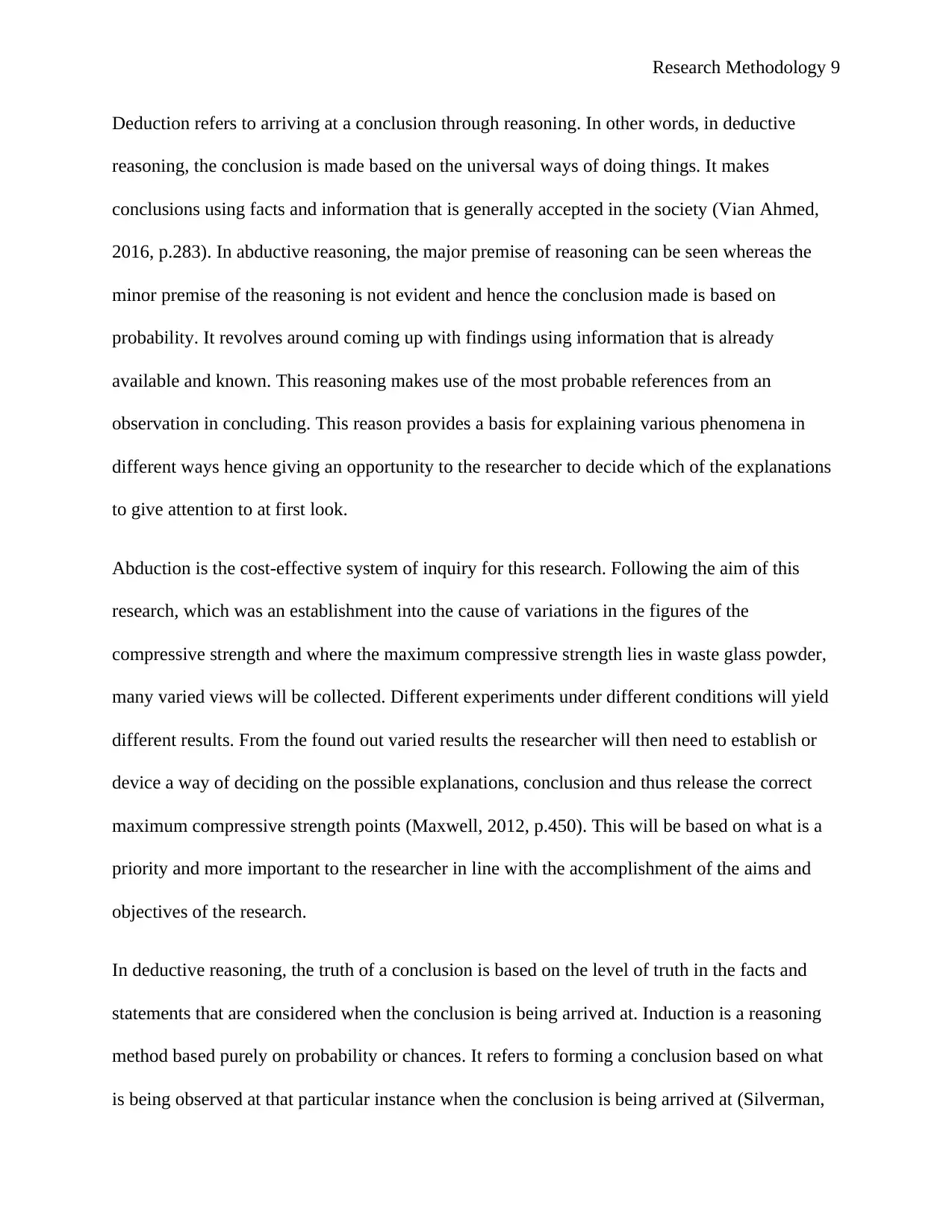
Research Methodology 9
Deduction refers to arriving at a conclusion through reasoning. In other words, in deductive
reasoning, the conclusion is made based on the universal ways of doing things. It makes
conclusions using facts and information that is generally accepted in the society (Vian Ahmed,
2016, p.283). In abductive reasoning, the major premise of reasoning can be seen whereas the
minor premise of the reasoning is not evident and hence the conclusion made is based on
probability. It revolves around coming up with findings using information that is already
available and known. This reasoning makes use of the most probable references from an
observation in concluding. This reason provides a basis for explaining various phenomena in
different ways hence giving an opportunity to the researcher to decide which of the explanations
to give attention to at first look.
Abduction is the cost-effective system of inquiry for this research. Following the aim of this
research, which was an establishment into the cause of variations in the figures of the
compressive strength and where the maximum compressive strength lies in waste glass powder,
many varied views will be collected. Different experiments under different conditions will yield
different results. From the found out varied results the researcher will then need to establish or
device a way of deciding on the possible explanations, conclusion and thus release the correct
maximum compressive strength points (Maxwell, 2012, p.450). This will be based on what is a
priority and more important to the researcher in line with the accomplishment of the aims and
objectives of the research.
In deductive reasoning, the truth of a conclusion is based on the level of truth in the facts and
statements that are considered when the conclusion is being arrived at. Induction is a reasoning
method based purely on probability or chances. It refers to forming a conclusion based on what
is being observed at that particular instance when the conclusion is being arrived at (Silverman,
Deduction refers to arriving at a conclusion through reasoning. In other words, in deductive
reasoning, the conclusion is made based on the universal ways of doing things. It makes
conclusions using facts and information that is generally accepted in the society (Vian Ahmed,
2016, p.283). In abductive reasoning, the major premise of reasoning can be seen whereas the
minor premise of the reasoning is not evident and hence the conclusion made is based on
probability. It revolves around coming up with findings using information that is already
available and known. This reasoning makes use of the most probable references from an
observation in concluding. This reason provides a basis for explaining various phenomena in
different ways hence giving an opportunity to the researcher to decide which of the explanations
to give attention to at first look.
Abduction is the cost-effective system of inquiry for this research. Following the aim of this
research, which was an establishment into the cause of variations in the figures of the
compressive strength and where the maximum compressive strength lies in waste glass powder,
many varied views will be collected. Different experiments under different conditions will yield
different results. From the found out varied results the researcher will then need to establish or
device a way of deciding on the possible explanations, conclusion and thus release the correct
maximum compressive strength points (Maxwell, 2012, p.450). This will be based on what is a
priority and more important to the researcher in line with the accomplishment of the aims and
objectives of the research.
In deductive reasoning, the truth of a conclusion is based on the level of truth in the facts and
statements that are considered when the conclusion is being arrived at. Induction is a reasoning
method based purely on probability or chances. It refers to forming a conclusion based on what
is being observed at that particular instance when the conclusion is being arrived at (Silverman,
⊘ This is a preview!⊘
Do you want full access?
Subscribe today to unlock all pages.

Trusted by 1+ million students worldwide
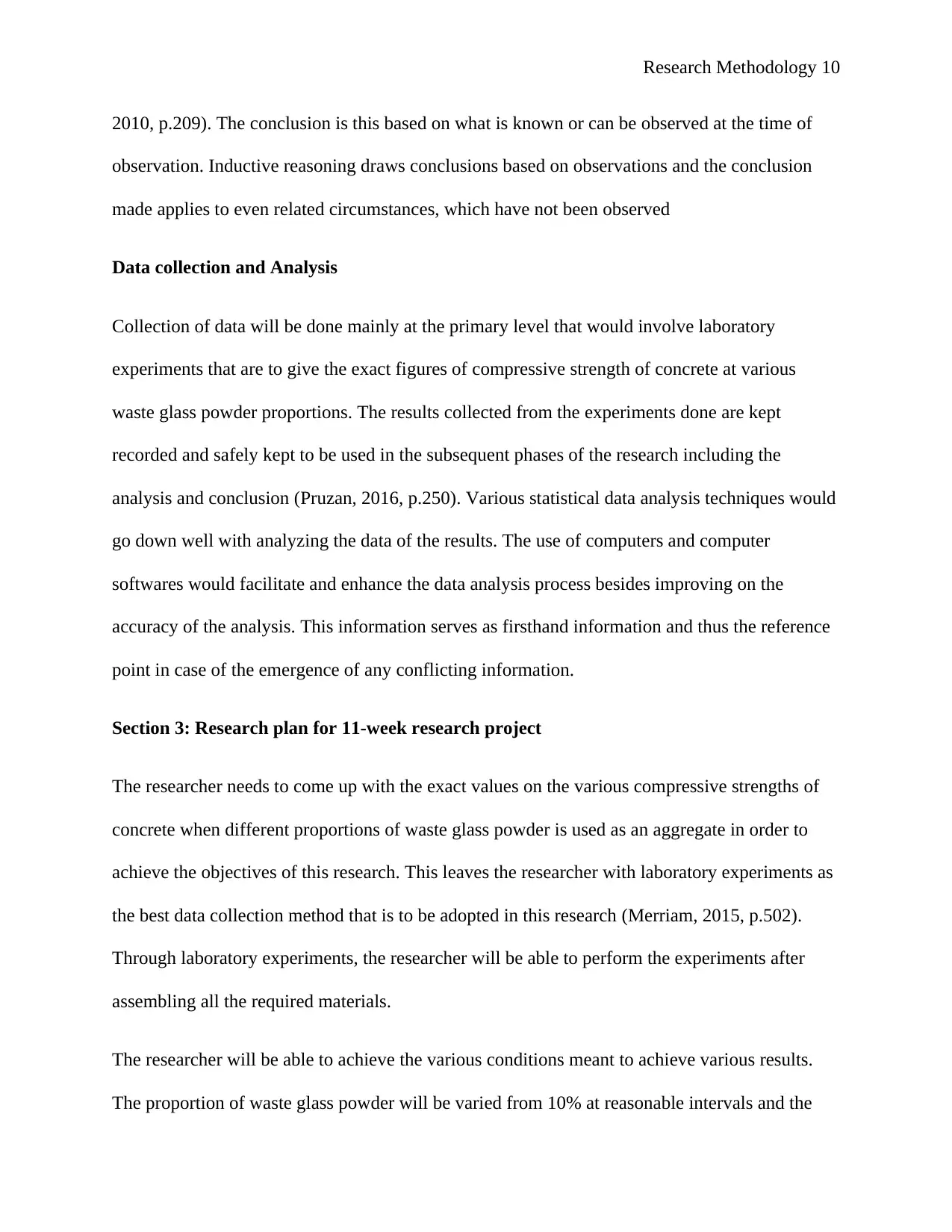
Research Methodology 10
2010, p.209). The conclusion is this based on what is known or can be observed at the time of
observation. Inductive reasoning draws conclusions based on observations and the conclusion
made applies to even related circumstances, which have not been observed
Data collection and Analysis
Collection of data will be done mainly at the primary level that would involve laboratory
experiments that are to give the exact figures of compressive strength of concrete at various
waste glass powder proportions. The results collected from the experiments done are kept
recorded and safely kept to be used in the subsequent phases of the research including the
analysis and conclusion (Pruzan, 2016, p.250). Various statistical data analysis techniques would
go down well with analyzing the data of the results. The use of computers and computer
softwares would facilitate and enhance the data analysis process besides improving on the
accuracy of the analysis. This information serves as firsthand information and thus the reference
point in case of the emergence of any conflicting information.
Section 3: Research plan for 11-week research project
The researcher needs to come up with the exact values on the various compressive strengths of
concrete when different proportions of waste glass powder is used as an aggregate in order to
achieve the objectives of this research. This leaves the researcher with laboratory experiments as
the best data collection method that is to be adopted in this research (Merriam, 2015, p.502).
Through laboratory experiments, the researcher will be able to perform the experiments after
assembling all the required materials.
The researcher will be able to achieve the various conditions meant to achieve various results.
The proportion of waste glass powder will be varied from 10% at reasonable intervals and the
2010, p.209). The conclusion is this based on what is known or can be observed at the time of
observation. Inductive reasoning draws conclusions based on observations and the conclusion
made applies to even related circumstances, which have not been observed
Data collection and Analysis
Collection of data will be done mainly at the primary level that would involve laboratory
experiments that are to give the exact figures of compressive strength of concrete at various
waste glass powder proportions. The results collected from the experiments done are kept
recorded and safely kept to be used in the subsequent phases of the research including the
analysis and conclusion (Pruzan, 2016, p.250). Various statistical data analysis techniques would
go down well with analyzing the data of the results. The use of computers and computer
softwares would facilitate and enhance the data analysis process besides improving on the
accuracy of the analysis. This information serves as firsthand information and thus the reference
point in case of the emergence of any conflicting information.
Section 3: Research plan for 11-week research project
The researcher needs to come up with the exact values on the various compressive strengths of
concrete when different proportions of waste glass powder is used as an aggregate in order to
achieve the objectives of this research. This leaves the researcher with laboratory experiments as
the best data collection method that is to be adopted in this research (Merriam, 2015, p.502).
Through laboratory experiments, the researcher will be able to perform the experiments after
assembling all the required materials.
The researcher will be able to achieve the various conditions meant to achieve various results.
The proportion of waste glass powder will be varied from 10% at reasonable intervals and the
Paraphrase This Document
Need a fresh take? Get an instant paraphrase of this document with our AI Paraphraser

Research Methodology 11
results and observations recorded at each proportion. Any changes to the chemicals used in the
experiment at any interval is noted and under circumstances that the experiment may need to be
repeated under the same conditions it will be done to establish the most accurate findings
(Boeije, 2009, p.266). Repeating experiments under the same conditions help in the elimination
of possible chances of doubt of the results or any errors that the researcher might have made
when performing the previous experiment.
Different colors of the waste glass powder will be used and the effect on the differences in the
color on the compressive strength would be noted as part of the observations. In case a specific
color may have different compressive strength properties from others, the difference would be
explained in the discussion section of the results analysis using the most relevant information
sources (Devi, 2017, p.206).
The researcher will as well include admixtures in the preparation of the concrete using waste
glass powder. Any notable changes in the overall compressive strengths at any proportions of
waste glass powder in the presence of admixtures are taken into consideration. The experiment
should be done in such a way that it accomplishes all the objectives of the research and that there
will be no information missing when it comes to the analysis stage (Lucienne T.M. Blessing,
2009, p.230). To achieve this, the experiment should be done in accordance with the objectives
of the research.
The findings from the research would be used in the analysis where they would be compared
against findings by other scholars and any consistencies or discrepancies noted. This would be
the point of dismissal or crediting of the findings of the other scholars of the same research and
would be a factor of whether or not the findings are the same with the scholar in question. Care
results and observations recorded at each proportion. Any changes to the chemicals used in the
experiment at any interval is noted and under circumstances that the experiment may need to be
repeated under the same conditions it will be done to establish the most accurate findings
(Boeije, 2009, p.266). Repeating experiments under the same conditions help in the elimination
of possible chances of doubt of the results or any errors that the researcher might have made
when performing the previous experiment.
Different colors of the waste glass powder will be used and the effect on the differences in the
color on the compressive strength would be noted as part of the observations. In case a specific
color may have different compressive strength properties from others, the difference would be
explained in the discussion section of the results analysis using the most relevant information
sources (Devi, 2017, p.206).
The researcher will as well include admixtures in the preparation of the concrete using waste
glass powder. Any notable changes in the overall compressive strengths at any proportions of
waste glass powder in the presence of admixtures are taken into consideration. The experiment
should be done in such a way that it accomplishes all the objectives of the research and that there
will be no information missing when it comes to the analysis stage (Lucienne T.M. Blessing,
2009, p.230). To achieve this, the experiment should be done in accordance with the objectives
of the research.
The findings from the research would be used in the analysis where they would be compared
against findings by other scholars and any consistencies or discrepancies noted. This would be
the point of dismissal or crediting of the findings of the other scholars of the same research and
would be a factor of whether or not the findings are the same with the scholar in question. Care

Research Methodology 12
must be taken to ensure that the experiments are done at the highest attainable levels of accuracy
since should the findings be inaccurate the conclusion will automatically be obsolete and hence
the researcher will credit the wrong scholar while dismissing the right one (McLeod, 2011,
p.342).
Week by week activities using an annotated diagram
0 Task Name 1 2 3 4 5 6 7 8 9 1
0
11
1 Proposal Development 3 weeks
2 Finding appropriate literature on the
research field-1
3 Identify a particular literature to find
the gap-1
4 Framing research
question/Aims/Rationale and
objectives-1
5 Preparing the outline proposal draft
and acquiring feedback from the
supervisor-2
6 Develop the research proposal-2
7 Submit the research proposal-2
8 Review feedback and complete the
research by refining it-3
9 Prepare the final research question-3
10 Literature Review 3 weeks
11 Conduct comprehensive and extensive
review on concrete preparation, the
properties of glass and reusability-4 &
5
12 Conduct comprehensive and extensive
review on the findings by different
must be taken to ensure that the experiments are done at the highest attainable levels of accuracy
since should the findings be inaccurate the conclusion will automatically be obsolete and hence
the researcher will credit the wrong scholar while dismissing the right one (McLeod, 2011,
p.342).
Week by week activities using an annotated diagram
0 Task Name 1 2 3 4 5 6 7 8 9 1
0
11
1 Proposal Development 3 weeks
2 Finding appropriate literature on the
research field-1
3 Identify a particular literature to find
the gap-1
4 Framing research
question/Aims/Rationale and
objectives-1
5 Preparing the outline proposal draft
and acquiring feedback from the
supervisor-2
6 Develop the research proposal-2
7 Submit the research proposal-2
8 Review feedback and complete the
research by refining it-3
9 Prepare the final research question-3
10 Literature Review 3 weeks
11 Conduct comprehensive and extensive
review on concrete preparation, the
properties of glass and reusability-4 &
5
12 Conduct comprehensive and extensive
review on the findings by different
⊘ This is a preview!⊘
Do you want full access?
Subscribe today to unlock all pages.

Trusted by 1+ million students worldwide
1 out of 15
Related Documents
Your All-in-One AI-Powered Toolkit for Academic Success.
+13062052269
info@desklib.com
Available 24*7 on WhatsApp / Email
![[object Object]](/_next/static/media/star-bottom.7253800d.svg)
Unlock your academic potential
Copyright © 2020–2025 A2Z Services. All Rights Reserved. Developed and managed by ZUCOL.




